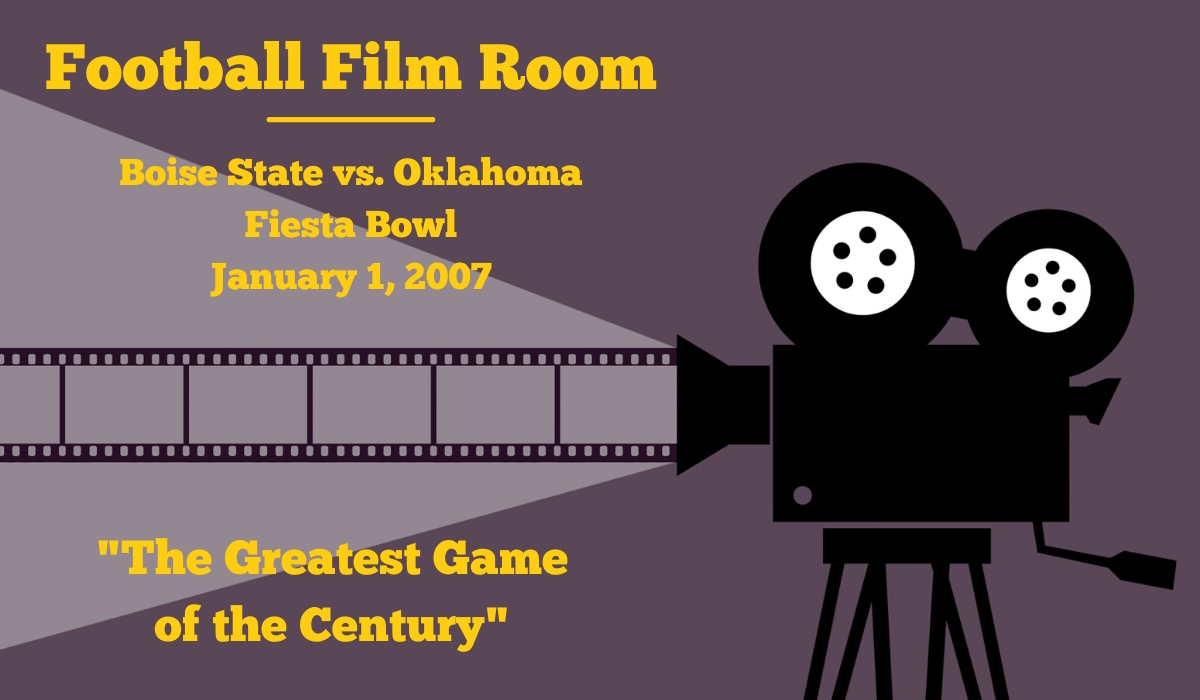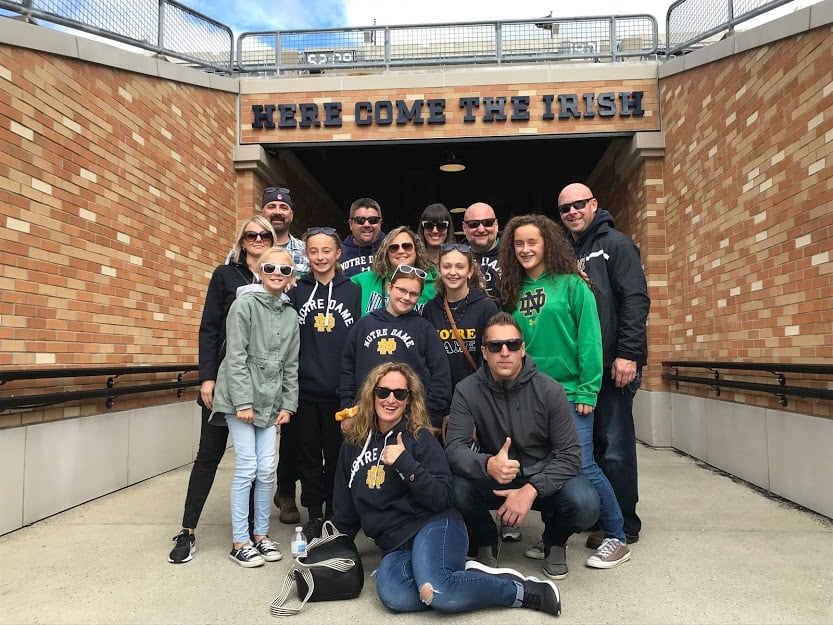Boise State vs. Oklahoma
Fiesta Bowl
January 1, 2007
Boise State: 43 | Oklahoma: 42
As I began doing research to decide which games I would choose for Football Film Room, an early Google search I started with “best college football games since 2000” - and I found plenty of games you’d expect: the 2006 Rose Bowl, the Iron Bowl Kick Return, the 2017 National Championship - all games, I’ll add, that we'll be covering in the weeks to come…
But none of those topped the list. Time and time again, a different game beat out all of them to be named the best college football game so far this century: the 2007 Fiesta Bowl between Boise State vs. Oklahoma.
And as I got set to revisit this, ironically, much like our last visit to the Fiesta Bowl for Miami vs. Ohio State from 2002, I knew about that one play - I’m sure you remember it, too. But what I forgot was just how good this game was, the clear stakes involved, the David vs. Goliath story, and a game that no one would soon forget.
But before we get to the game, let’s go back in time to 2007, and find out just where the Broncos and Sooners were as they met on a warm night in Tempe…
Where our story begins…
There was plenty to make fun of when it came to the BCS system - and you know I sure did.
And why not? It had given us everything from national championships between teams ranked #2 and #3, to insufficient explanations as to why one undefeated team was more “deserving” than another - and while the current playoff system has plenty of its own flaws, it’s hard to argue it’s been a more satisfying way to crown a national champion. In fact, there’s a whole Wikipedia article with a year by year breakdown of controversies in the BCS, so the whole thing just felt unsustainable after awhile.
But the BCS system did give us one thing that shouldn’t go unnoticed, even if it may have been unintended on the part of the BCS itself. And for that, we’ll need a quick history refresher...
See, when the “Bowl Coalition” was formed in 1994 by Notre Dame, the SEC, ACC, Big East, SWC, and Big 8 (the latter of whom would further sever off to form what would become the Big 12 conference before the 1994 season started), it was largely seen as a way to capitalize on the national popularity of the sport’s best programs by formalizing a national championship game at the end of the year. With the bowl system being largely a group of independent governing bodies across the country, each with their own invite rules, the top two teams in the had only played each other in a bowl game six times since 1968. College football needed a central crown - something to cap and celebrate the season the way *checks* every other college sport had at the time.
And after some back and forth over the following few years between the Big Ten and Pac-10, along with the Rose Bowl committee, in 1998 the BCS system was finalized, and college football was ready to finally have an undisputed national champion every year. The “Power Five” conferences would get automatic bids to the top bowl games to ensure each conference was satisfied… while the decision to add mid-majors (now known as the “Group of Five” conferences) into the qualifying criteria felt, at least at the time, like “covering their bases”, rather than something they would need to keep returning to.
But... return they did. Between 1998 and the dissolution of the BCS system, 11 teams not in the Power Five (and excluding Notre Dame) would have undefeated regular seasons - but none of them qualified for the national championship game. Yes, in an attempt to consolidate one champion, the BCS had unwittingly created the perfect platform to question why some conferences had an easier path to being crowned... every single year.
And by the mid-2000s, this had come to a head, first with the 2004 Utah Utes (who became the first Group of Five team invited to a New Years bowl game, where they handily beat #19 Pitt), then with the ascension of Boise State in 2006, which was more than a little surprising at the time.
The Broncos, after all, had only joined Division 1-A less than ten years ago, and while they had found success in the form of seven conference championships, six bowl invites, and three top 25 finishes in the AP poll… they would begin the 2006 season unranked, led a first year head coach named Chris Petersen, and with odds to make the national championship that hung around +30000.
But then they started winning. And winning… and winning some more.
Their victory over Utah at the end of September turned some heads, and their next eight wins, a WAC championship, and a 12-0 record gave them what no Group of Five team, not even that Utah team from just a few years prior, had gotten before: a top-ten bowl match-up on New Years’ Day, in prime time, against one of the sports’ winningest programs: the Oklahoma Sooners.
But Oklahoma had walked their own unlikely road heading into this season - first losing QB Rhett Boomer in the preseason, leaving former wide receiver Paul Thompson to take over just one month before the 2006 season was set to begin. Then, all-world running back Adrian Peterson went down with a collarbone injury during what should have been a Heisman campaign. Add to that a wacky play in Oregon that took a win away from the Sooners, a blowout loss to Texas in the Red River Shootout - and the fact that the Sooners won the Big 12, walked into the Fiesta Bowl at 11-2, and were a one touchdown favorite was almost as shocking as the opponent they met there.
But even with how surprising the circumstances were, nothing could have prepared us for all the twists and turns once this one got underway...
How it happened…
If this game was billed as a “David and Goliath” match-up, then through the first three quarters… it became increasingly clear that David didn't get the memo. On the first drive, Boise State QB Jared Zabransky hit Drisan James for a 49-yard touchdown pass off an absolutely filthy play action. Then, on the first play of Oklahoma’s next drive, Paul Thompson was stripped in the pocket - only to see the ball recovered by the Broncos and run right back in for a touchdown to put Boise State up 14-0.
Things started to normalize soon after that, if only for a few possessions. Oklahoma put together a 14 play, 82 yard drive that was capped by a Thompson pass to Manuel Johnson - and even after Thompson’s second turnover on an interception to Marty Tadman, the defense held the Broncos’ to a quick punt and the offense got back on the board with a field goal, making it 14-10 with just over five minutes left to go.
Boise State, however, would be far from satisfied to simply go back into the locker room up four. With just a minute and a half left to go in the half, the Broncos once again dialed up the big play - this time as a scrambling Zabranksy sent what looked like some kind of a checkdown pass to James on the outside. James wiggled his way through the Sooner secondary, and somehow found his way to the endzone. 21-10, Broncos.
Out of halftime, things seemed to be going from bad to worse for the Sooners, as Thompson threw two-straight interceptions, the latter of which was returned all the way back for another Boise State touchdown to go up 28-10. By this point, the sea of orange in the stadium was going absolutely wild.
But behind the big plays, the groundwork was being laid for the Sooners to come back. Oklahoma’s defense bore down on Zabransky, and Boise State wouldn’t get a single first down through the entirety of the third quarter. They fumbled a punt recovery, which Oklahoma turned into an Adrian Peterson touchdown - and when they added another field goal to make it a 28-20 ballgame… all of the sudden the momentum finally felt like it was shifting back towards the Sooners.
For most of the fourth quarter, though, it was a defensive stalemate. Oklahoma’s inability to convert offensively made a what could have been a key fumble from Boise State into just a benign mistake - and as the two teams continued trading punts back and forth, you kept waiting for the page to turn towards the final chapter...
And then, boy, did it ever.
In the final three minutes of regulation, all of the following happened:
-
- Oklahoma took the ball 77 yards on just six plays and capped their scoring drive with a tipped pass to Quentin Cheney to make it 28-26.
- They missed the two-point conversion, but Boise State was called for pass interference.
- They made the conversion on the re-try, but were called for an illegal shift.
- They made the conversion again, and we were tied.
- On the next drive, Oklahoma returned the favor from the third quarter, getting a touchdown off a pick-six of their own to now go ahead by a touchdown, 35-28.
- Boise State then got the ball back and converted a 4th and 18 on a hook and ladder trick play for a 35 yard touchdown to tie up the game with just seven seconds left to play.
Again. That all happened in the final three minutes.
Oklahoma started with the ball in overtime, and Adrian Peterson took the ball right in for a touchdown on the first play - going for a 25 yard touchdown to put Oklahoma up 42-35.
Boise State got the ball back, and were much more meticulous with their drive back down the field - seeming to just inch their way towards the endzone. Then, on fourth and two, the Broncos motioned Zabransky out to the left and set up a wildcat formation with trips to the weakside on the right and receiver Vinny Peretta taking the snap. Perretta rolled out to the right and found Derek Shouman, who had slipped into the back of the endzone, for a six yard touchdown pass.
And then the play happened.
Now, for those of you following along - you're right: that last touchdown left the game at 41-42, which people forget! I forgot! Chris Petersen didn’t have to call this play. He didn’t have to do anything but kick the field goal and try to get back on defense. But he hadn’t played it safe yet all night… so why start now?
On the two point conversion, Boise State put Zabransky under center, with Ian Johnson behind him. Zabransky snapped the ball, dropped back, and threw to the right.
Only he didn’t throw to the right.
The entire stadium just thought he had thrown to the right.
And by the time everyone realized that we had just watched the first Statue of Liberty play run in a major bowl game in gosh I don’t even know how long… Ian Johnson was waltzing, untouched, into the endzone for a touchdown. 43-42 Boise State.
Ballgame.
Instant reaction to the rewatch
Chris Petersen’s play calling, man
I mentioned Chris Petersen taking risks already but it deserves its own section. This guy didn’t just show up to the dance, he handed the DJ his playlist and cut a rug for three hours.
On a night when too often Oklahoma played it a little safe, perhaps just waiting for the carriage to turn back into a pumpkin on Boise State’s Cinderella story, Petersen pulled out all the stops and truly coached to win, not to avoid losing. He gave Zabransky the green light to just chuck the ball deep right from the get go, sent pressure to challenge Paul Thomas to beat them deep, and simply outmaneuvered one of the best coaches in the country in Bob Stoops. Petersen would of course go on to have a successful run at Washington before stepping down at the end of this past season, but even after all this time, this really felt like his piece de resistance.
Chris Petersen’s play calling against Brent Venebles
Over the past eight years at Clemson, Brent Venebles has made quite a name for himself as arguably the best defensive tactician in college football - which makes the fact that Petersen’s offensive chess game came against Brent Venebles Oklahoma defense back in 2007 even more impressive.
It wasn’t all bad for Venebles - in fact, they held Boise State to just 377 total yards, including just 110 yards on the ground, a season-low for the Broncos. Boise State was just 4-14 on third downs, had seven fewer first downs than the Sooners, and it’s worth remembering that 14 of Boise State’s points came after Oklahoma turnovers.
But on the rewatch, it’s the big plays that kill you - and in almost every key moment, Venebles was outplayed. The fourth down hook and ladder, the missed tackles on the checkdown pass to James to end the first half, and of course, the Statue of Liberty play - all are moments Venebles no doubt learned from, but that were the story of this game.
Boise State’s defense on Adrian Peterson
Hey speaking of defense…
Part of what made Boise State’s performance so impressive is just how much they sold out to stop Adrian Peterson… and how much it worked.
Granted, Peterson was coming off of a collarbone injury, but even with that he went for just 77 yards on 20 carries - as the Broncos just threw everyone into the box and dared Paul Thompson to win the game by himself. Thompson had a few big plays, and Peterson did have two touchdowns, including the one to open up OT - that kind of strategy always will yield those moments.
But they were few and far between enough for Boise State to prevent the Sooners from getting and keeping an offensive rhythm.
What’s stood the test of time
The Play
The Statue of Liberty play has become one of the greatest plays in college football history - and along with winning an ESPY for “Best Play” that year, is basically on every highlight reel for “classic football moments” they run every fall.
I mean it just had everything: a trick play - one that every one of us used to try when we played football with our friends as kids - to help an underdog win one of the biggest bowl games of the year? Come on. What else do you want?
The Game
Of course, that trick play only becomes as big as it was if the game is good enough to match it - and this one was all that and then some.
The 2007 Fiesta Bowl won the ESPY for “Best Game” - and as I mentioned in my intro, it still tops lists as the best college football game so far this century. Rewatching it, it’s hard to argue… but more on that in a bit.
Group of Five teams wanting more shots at the big stage
A lot has changed about college football since this one, but every few years there’s another undefeated Group of Five team that demands a seat in the spotlight with an undefeated record, and jaw-dropping stats. It’s been awhile since Boise State has been in the conversation (especially since Petersen left), but from TCU (now in the Big 12), to UCF (who actually declared themselves national champions in 2017 after going undefeated) - even the CFP can’t stop the feeling that automatic bids into the top bowl games prevent smaller conference teams from getting their shot.
And despite the success of these programs, we’re still waiting on our first playoff berth from a Group of Five team, let alone a national championship appearance (sorry, UCF).
Why this game
The better question is… why not this game?
I can definitively say that this has been the best game I’ve watched so far. Period.
It’s easy to get hyperbolic about sports - especially in the moment. The number of times you hear announcers declare “this is one of the best games we’ve seen all year” is enough to fill a calendar by itself. But not only does this game deliver the goods, it actually recalibrates what a great game is. All the games I watch from now on will be graded on a scale from “one, to the 2007 Fiesta Bowl.” If you’re serious about college football rewatches, this one has to top your list.
In fact, I’m just gonna go ahead and cue it up again… see everyone next week.
What do you think? Did this game hold up? Was it your favorite of the century so far? Let me know! Email hank@rentlikeachampion.com with your thoughts...




.jpg)
.jpg)
